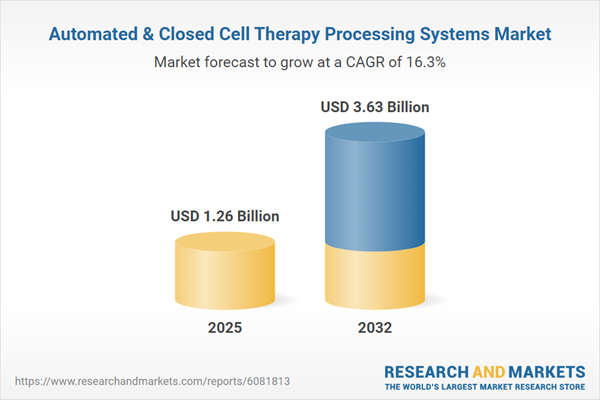Speak directly to the analyst to clarify any post sales queries you may have.
The Automated & Closed Cell Therapy Processing Systems Market is rapidly redefining advanced therapy manufacturing with integrated solutions that help organizations improve scalability, compliance, and operational consistency. As automation aligns with closed-system architecture, decision-makers gain important options to drive efficiencies and future-proof production.
Market Snapshot: Automated & Closed Cell Therapy Processing Systems Market
The global Automated & Closed Cell Therapy Processing Systems Market expanded from USD 1.08 billion in 2024 to USD 1.26 billion in 2025. With a projected CAGR of 16.25%, the market is poised to reach USD 3.63 billion by 2032, reflecting strong demand across biopharmaceuticals and clinical manufacturing.
Robust investment, emerging regulatory frameworks, and process innovations are collectively supporting system adoption in both clinical and commercial-scale environments.Scope & Segmentation
This report delivers a detailed segmentation of the Automated & Closed Cell Therapy Processing Systems Market, providing senior leaders with transparency into the critical product, processing, and regional variables:
- Product Type: Automated Systems; Closed Systems
- Application: Allogeneic therapies including Hematopoietic Stem Cell, Mesenchymal Stem Cell, Natural Killer Cell; Autologous therapies including CAR T Cell, Hematopoietic Stem Cell, Mesenchymal Stem Cell
- Technology: Centrifugation (Density Gradient, Fixed Angle, Swing Bucket); Filtration (Microfiltration, Ultrafiltration); Magnetic Separation (Immunomagnetic Bead, Paramagnetic Separation)
- End User: Contract Research Organizations; Hospitals & Clinics; Pharmaceutical & Biotech Companies; Research Institutes
- Process Type: Cell Counting & Analysis (Automated, Manual); Cell Preparation (Formulation, Thawing); Cell Separation (Centrifugation, Filtration, Magnetic); Cell Storage (Long Term, Short Term); Cell Washing (Automated, Manual)
- Regional Coverage: Americas (North America—United States, Canada, Mexico; Latin America—Brazil, Argentina, Chile, Colombia, Peru), Europe, Middle East & Africa (Europe—United Kingdom, Germany, France, Russia, Italy, Spain, Netherlands, Sweden, Poland, Switzerland; Middle East—United Arab Emirates, Saudi Arabia, Qatar, Turkey, Israel; Africa—South Africa, Nigeria, Egypt, Kenya), Asia-Pacific (China, India, Japan, Australia, South Korea, Indonesia, Thailand, Malaysia, Singapore, Taiwan)
- Companies Analyzed: Thermo Fisher Scientific Inc., Miltenyi Biotec GmbH, Terumo BCT Inc., Lonza Group AG, Cytiva Inc. (a Danaher business), Sartorius AG, Becton Dickinson and Company, Bio-Techne Corporation, STEMCELL Technologies Inc., Merck KGaA
Key Takeaways: Insights for Senior Decision-Makers
- Automated and closed processing platforms are central to standardizing manufacturing and reducing contamination risks in cell therapy production.
- System selection increasingly hinges on platform compatibility with diverse cell types and integration flexibility across different operational environments.
- Technological advances such as robotics, integrated analytics, and modularity are supporting higher throughput and more reliable quality outcomes.
- Operational focus is shifting toward end-to-end documentation and digital batch record generation to comply with dynamic regulatory requirements.
- Region-specific investment and policy environments are shaping deployment strategies, with tailored solutions gaining traction in growth markets.
- Strategic partnerships and supply chain resilience are becoming decisive factors for manufacturers aiming to accelerate product roll-outs and maintain cost controls.
Tariff Impact: Navigating 2025 U.S. Trade Policy Shifts
The 2025 U.S. tariff regime introduces increased costs for imported bioprocessing equipment, consumables, and reagents. Original equipment manufacturers may shift sourcing toward domestic or near-shored suppliers to mitigate impacts on the total cost of ownership. These changes could lengthen sales cycles and prompt negotiation of cost-sharing agreements or the redesign of platforms to ensure continued competitiveness. Global supply chains will need to diversify, and tariff-friendly product variants may become crucial to safeguarding uninterrupted therapy delivery.
Methodology & Data Sources
The report’s research framework blends primary interviews with senior industry stakeholders and secondary analysis of peer-reviewed publications, regulatory filings, and vendor disclosures. Triangulation of data sources ensures validation and accuracy for both quantitative and qualitative findings, delivering a robust and actionable market assessment.
Why This Report Matters
- Enables executives to align investment and procurement strategy with the latest segmentation insights and emerging regulatory landscapes.
- Supports technology leaders in benchmarking operational models and identifying innovation opportunities based on evolving process requirements.
- Equips stakeholders with actionable intelligence to adapt supply chains and product offerings amid shifting global trade policies.
Conclusion
Automated and closed cell therapy processing systems are transforming advanced therapy manufacturing through standardization, process optimization, and compliance. Leaders leveraging these solutions are poised to achieve operational excellence and sustainable market advantage in an evolving global landscape.
Table of Contents
3. Executive Summary
4. Market Overview
7. Cumulative Impact of Artificial Intelligence 2025
Companies Mentioned
The companies profiled in this Automated & Closed Cell Therapy Processing Systems market report include:- Thermo Fisher Scientific Inc.
- Miltenyi Biotec GmbH
- Terumo BCT, Inc.
- Lonza Group AG
- Cytiva Inc. (a Danaher business)
- Sartorius AG
- Becton Dickinson and Company
- Bio-Techne Corporation
- STEMCELL Technologies Inc.
- Merck KGaA
Table Information
| Report Attribute | Details |
|---|---|
| No. of Pages | 193 |
| Published | October 2025 |
| Forecast Period | 2025 - 2032 |
| Estimated Market Value ( USD | $ 1.26 Billion |
| Forecasted Market Value ( USD | $ 3.63 Billion |
| Compound Annual Growth Rate | 16.2% |
| Regions Covered | Global |
| No. of Companies Mentioned | 10 |









